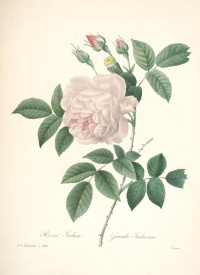Pierre-Joseph Redouté
From The Art and Popular Culture Encyclopedia
|
"Jacques Le Moyne de Morgues, Georg Dionysius Ehret, Nicolas Robert, Jacob Marrel, Pierre Joseph Redouté, Maria Sibylla Merian, Pierre Vallet, G.B. Ferrari."--L'oggetto libro: arte della stampa, mercato e collezionismo (1997) "Pierre-Joseph Redouté, le peintre le plus célèbre de la famille, étourdit sa mère de ses premiers cris le 10 ... Vilvorde pendant une année entière , il s'y occupa uniquement à orner des salles, à exécuter des dessus de portes et ..."--Histoire de la peinture flamande depuis ses débuts jusqu'en 1864 (1876) by Alfred Michiels |

|
Related e |
|
Featured: |
Pierre-Joseph Redouté (1759 – 1840), was a Belgian painter and botanist, known for Les Liliacées and Les Roses, watercolours of lilies and roses.
He was an official court artist of Queen Marie Antoinette, and he continued painting through the French Revolution and Reign of Terror. Redouté survived the turbulent political upheaval to gain international recognition for his precise renderings of plants, which remain as fresh in the early 21st century as when first painted.
Paris was the cultural and scientific centre of Europe during an outstanding period in botanical illustration (1798 – 1837), one noted for the publication of several folio books with coloured plates. Enthusiastically, Redouté became an heir to the tradition of the Flemish and Dutch flower painters Brueghel, Ruysch, van Huysum and de Heem. Redouté contributed over 2100 published plates depicting over 1800 different species, many never rendered before.
Contents |
Early life
Redouté was born in Saint-Hubert, Luxembourg; the town is now in Belgium.
Although he was relatively lacking in formal education, both Redouté's father and grandfather were painters. He left home at the age of 13 to earn his living as an itinerant Belgian painter, doing interior decoration, portraits and religious commissions.
Paris
In 1782 Redouté joined his elder brother, Antoine Ferdinand, an interior decorator and scenery designer in Paris. There he met the botanist and book lover Charles Louis L'Héritier de Brutelle, and René Desfontaines, who steered him towards botanical illustration, a rapidly growing discipline.
In 1786 Redouté began work at the Muséum national d'histoire naturelle cataloguing the collections of flora and fauna and participating in botanical expeditions, notably Bonaparte's Egyptian expedition. In 1787, he left to study plants at the Royal Botanic Gardens, Kew near London.
In 1788, Redouté returned to Paris. In 1792 he was employed by the French Academy of Sciences. Cheveau, a Parisian dealer, brought the young artist to the attention of the Dutch botanical artist Gerard van Spaendonck at the Jardin du Roi, which became the Jardin des Plantes of the Muséum national d'histoire naturelle in 1793, after the Revolution. Van Spaendonck became Redouté's teacher, L'Heritier his patron who taught him to dissect flowers and portray their diagnostic characteristics. L'Heritier also introduced Redouté to members of the court at Versailles. Marie Antoinette became his patron. Redouté received the title of Draughtsman and Painter to the Queen's Cabinet.
In 1798, Empress Joséphine de Beauharnais, the first wife of Napoleon Bonaparte, became his patron and, some years later, he was her official artist. In 1809, Redouté taught painting to Empress Marie-Louise of Austria.
Later career and legacy
After Josephine's death, Redouté's fortunes fell until he was appointed as a master of design for the Museum d'Histoire Naturelle in 1822. In 1824, he gave some drawing classes at the Muséum national d'histoire naturelle. He taught many female royal personages, mostly Belgian. He became a Chevalier of the Légion d'honneur in 1825. Although particularly renowned for his botanical exploration of roses and lilies, he thereafter produced paintings purely for aesthetic value including those of the celebrated Choix des plus belles Fleurs.
Redouté was capable of overcoming successive political crises, without great struggle, and surviving under different political régimes. He collaborated with the greatest botanists of his day and participated in nearly fifty publications. Over his long career, Redouté painted the gardens at the Petite Trianon of Marie Antoinette as her official court artist. During the French Revolution and Reign of Terror, he was appointed to document gardens which became national property. However, during the patronage of the generous Empress Josephine, Redouté's career flourished and he produced his most sumptuous books portraying plants from places as distant as Japan, South Africa and Australia as well as Europe and America.
He died June 19 or 20, 1840 and was interred in Père Lachaise Cemetery.
Linking in in 2024
À la poupée, Acacia linifolia, Adélaïde d'Orléans, Alfred Riocreux, Allium carolinianum, Allium longispathum, Allium moschatum, Allium scorzonerifolium, André Lawalrée, Anigozanthos flavidus, Antonia Ridge, Artists in Isabey's Studio, Babiana tubiflora, Babiana villosa, Banksia repens, Botanical illustration, Callistephus, Camille de Chantereine, Charles Bennet, 4th Earl of Tankerville, Charles Louis L'Héritier de Brutelle, Château de Compiègne, Château de Malmaison, Château de Meudon, Choix des plus belles fleurs, Colin Brown (artist), Cyperus dives, David Redden, Dianthus caryophyllus, Dorothea Nicolai, Drimia elata, Dumbarton Oaks, Édouard Maubert, Émile Reynaud, Erich Nelson, Étienne Pierre Ventenat, Flora Caressed by Zephyr, Flore des Serres et des Jardins de l'Europe, François André Michaux, Friends of the Natural History Museum Paris, Gerard van Spaendonck, Graham Arader, Harry Bolus, Henri Antoine Jacques, Henriette Vincent, Hydrangea, Inès Esménard, Institut Redouté-Peiffer, Jacques Philippe Martin Cels, Jan Frans van Dael, Joséphine de Beauharnais, Joseph-Laurent Malaine, Kalmia polifolia, Kew Gardens, Lachenalia contaminata, Les Vélins du Roi, Liliaceae, Lise Cloquet, List of florilegia and botanical codices, List of graphic artists in the Web Gallery of Art, List of most expensive books and manuscripts, Lloyd Library and Museum, Martyn Rix, Musée de la Vie romantique, Narcissus (plant), Narcissus cyclamineus, Nathalie Elma d'Esménard, Nicolas Huet the Younger, Novae Hollandiae Plantarum Specimen, Palace of Fontainebleau, Pancrace Bessa, Pansy, Penguin Books, Pierre Antoine Poiteau, Relation du Voyage à la Recherche de la Pérouse, Rosa hemisphaerica, Rose, Tigridia pavonia, Tigridia, Tulipa agenensis, Tulipa clusiana
See also

